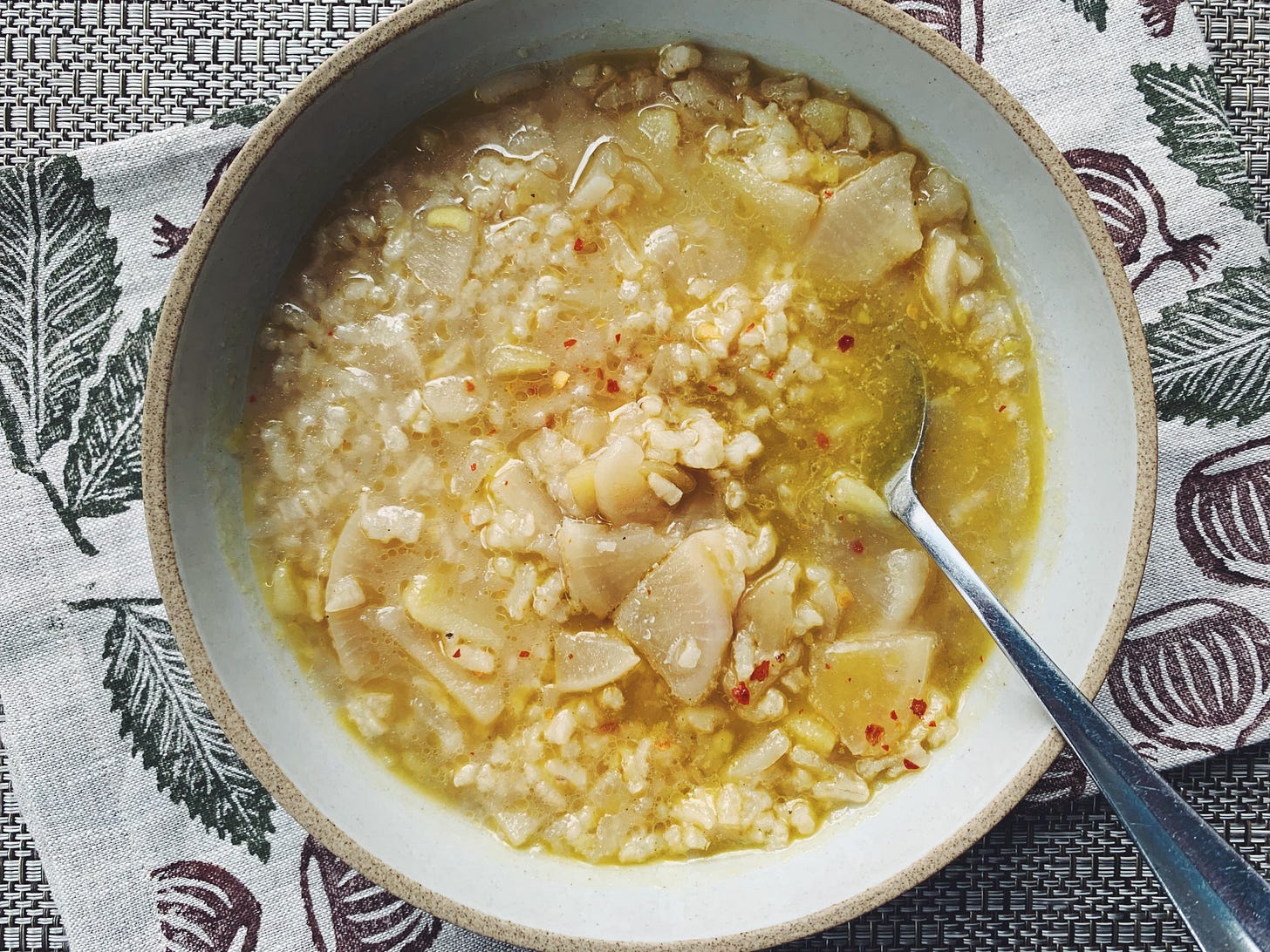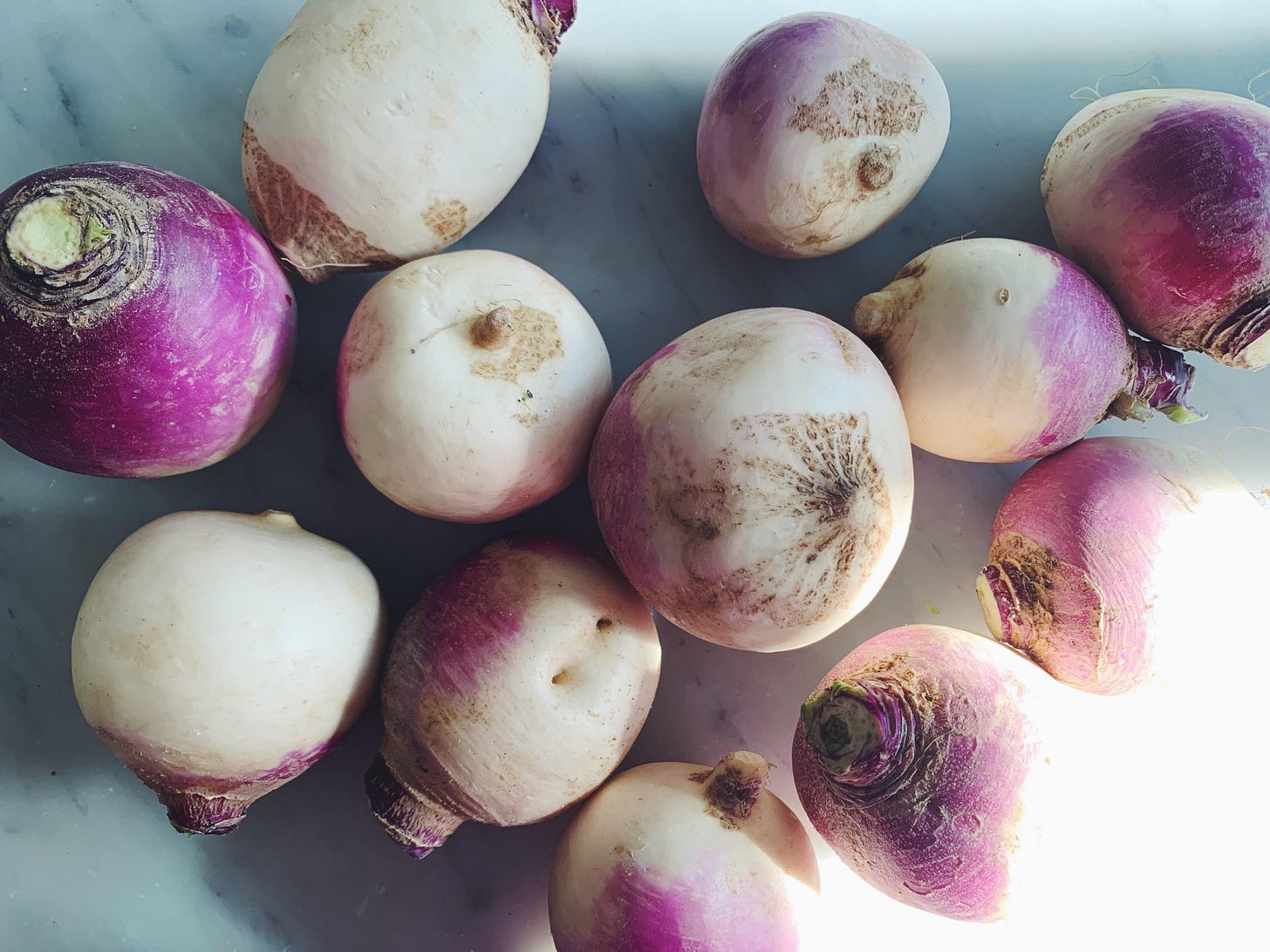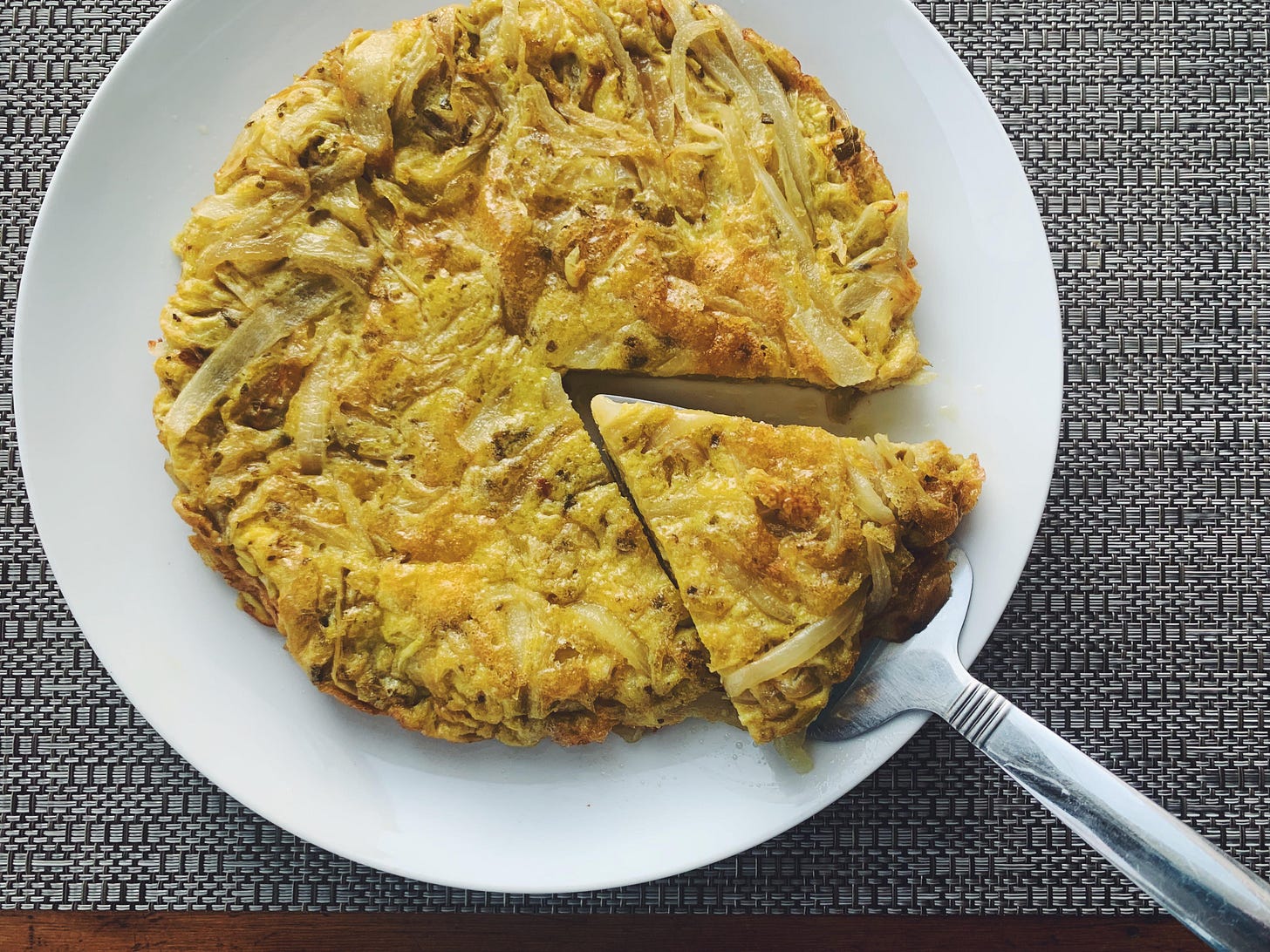Pausing the Holiday (Sugar) Rush
Taking a break from sweets to share two simple, savory recipes

Welcome to Buona Domenica, a weekly newsletter of inspired Italian home cooking and baking. I’m a journalist, cooking instructor, occasional tour guide, and author of eight cookbooks on Italian cuisine. Looking for a particular recipe? You’ll find all Buona Domenica recipes indexed here, ready to download or print.
Cookbook Winner: The lucky winner of Giuseppe’s Easy Bakes is Susan Etheredge. Congratulations, Susan! Please check your inbox for an email from me.
Christmas Eve Menu: A few days ago I cross-posted my friend ’s newsletter, which includes a sumptuous seafood menu for Christmas Eve, with downloadable recipes (including one from me). Here’s the link in case you missed it the first time around. I myself will adding a couple of these stellar dishes to my traditional Christmas Eve dinner, which I wrote about last year.
This week’s recipes: Frittata di Cipolla (onion frittata), for all subscribers; and Rape e Riso (brothy turnip and rice soup) for paid subscribers. Both recipes are from Portico: Cooking and Feasting in Rome’s Jewish Kitchen, by Leah Koenig. If you’re looking for easy, delicious dishes to serve in between elaborate holiday meals, you will appreciate these two recipes.
Holiday Discount! I’m offering 20% off a paid annual subscription to Buona Domenica. Click on the green box to take advantage of this special offer and join our community of Italian food lovers.
On to the newsletter…
Friends, I need a break from sugar. Maybe you do, too?
Don’t get me wrong—I’m not saying I’m done with holiday baking, not even close. But after November’s pumpkin panna cotta and chestnut cake; and December’s mostaccioli and walnut cake; not to mention two back-to-back weekends of Italian Christmas Cookie classes (with more cookie baking to come), I have been craving pretty much the opposite of butter-rich, nut-studded, sugar-coated things. In other words, simple, savory food.
I turned to a cookbook I have been enjoying ever since I bought it earlier this fall. Portico: Cooking and Feasting in Rome’s Jewish Kitchen, by Leah Koenig, is a collection of recipes from Rome’s Jewish Ghetto neighborhood (the title comes from the Portico d’Ottavia, the ancient brick and marble doorway that still stands at the edge of the neighborhood). But it is much more than that. It is an homage to a community that dates back more than 2,000 years. And it’s a tribute to the resilience of the people of this community, who for the vast majority of those millennia were forced to live in hostile, humiliating conditions, enclosed in a four-by-four-block area, and who somehow found a way to flourish. There are moments of history outlined, vignettes depicting life in the quarter, and profiles of cooks and other personalities who grew up there.
In the introduction, Leah, who also writes
newsletter here on Substack, notes that Rome’s Jewish quarter gave birth to “a distinctive take” on Italy’s and Rome’s cucina povera (poor man’s cuisine). “From the small fish* they were permitted to purchase at the market came endive and anchovy pies, as well as rustic stews that melted anchovies into the soffritto (a base of aromatics, similar to the French mirrepoix). Using the inexpensive ‘throwaway’ parts of cows and lambs…they simmered enticing dishes that would become classics of Roman cuisine. And with the abundance of locally produced olive oil, they created an entire canon of deep-fried dishes.”Most famous among the “fritti” are carciofi alla Giudea—deep-fried artichokes, for which there is a recipe in the book. There are plenty of other enticing dishes, too: Minestrone with Meatballs, Braised Oxtail Stew, Whole Roasted Fish with Raisins and Pine Nuts, and a variety of rustic cakes, tarts, and other sweets. The latter half of the 20th Century saw the arrival of several thousand Jewish immigrants from Libya, who brought with them the flavors of North Africa. The recipes for Cershi Bel Hal, a garlicky pumpkin spread with hot paprika; Lubia Bel Kammùn, a beef and white bean stew with cumin; and Safra, a citrus syrup-infused semolina cake, showcase the African influence.
I already have at least four other books on the cuisine of the Eternal City, but Leah’s book has added a whole new facet.
* Among the many harsh restrictions placed on Rome’s Jewish population over the centuries, they were prohibited from buying large species of fish. So instead, families subsisted on fish scraps and small fish like anchovies, mackerel, and sardines.
I’m sharing two recipes from Portico that beautifully exemplify what I mean by “simple, savory food”— Frittata di Cipolle (onion frittata), and Rape e Riso (Brothy Rice and Turnip Soup, pictured above). They have few ingredients, are easy to make, and they deliver in flavor and in cold-weather comfort. Also, if you’re looking for unfussy, delicious dishes to serve in between the celebration meals, especially if you’re busy decorating cookies or menu planning and prepping, you will appreciate these two recipes.
The frittata recipe is below, for all subscribers. It is nearly 50-50 onions to eggs, which gives it texture and a pungent onion sweetness. The rice and turnip soup is accessible to paid subscribers. And let me say a word about turnips here: this ever so humble root vegetable deserves a lot more appreciation. I did not grow up eating turnips. I started buying baby ones at the farmers’ market years ago. I usually roast them, on their own or with potatoes, or add one or two cut-up ones to lentil soup. They have a sweet undertone, which is punctuated by a spicy and bitter kick. Also, they are pretty (see photo above). And although I was slightly skeptical at how they would fare as the star ingredient in a soup, I needn’t have worried. The sliced turnips “grow silky and luscious as they cook” as Leah puts it, and their spicy bite mellows. My daughter, who enjoyed leftovers for lunch the next day, said the soup was like “Italian congee.”
RECIPE: Frittata di Cipolle
I have always loved a simple frittata, but when I first read the recipe for frittata di cipolle (onion frittata) in Leah Olsen’s book Portico: Cooking and Feasting in Rome’s Jewish Kitchen, I wondered if it might be too simple. It contains just four ingredients: eggs, onions, extra-virgin olive oil, and salt. But, as Leah points out in her headnote, “here’s the thing: it’s fantastic.” She is right! The flavor comes from using good ingredients and from cooking the onion to a soft golden-brown to bring out its sweetness.
The recipe is from Micaela Pavoncello, a Roman guide who specializes in tours of the city’s historic Jewish Ghetto and who shared the recipe with Leah after preparing it for her synagogue’s sukkah one night. When I made it the first time (I’ve made it several times), it immediately reminded me of all the best frittatas that I’ve enjoyed over the years, plain, unadorned, eaten by hand at room temperature or stuffed into a sandwich for the ultimate road trip food. The only change I made to Leah’s recipe was to use a large, sweet onion (it was either a Vidalia or a Maui) in place of two medium yellow onions.
Leah recommends serving the frittata with pizza bianca, a staple of Roman and Jewish Roman cuisine (she includes a recipe in the book).
(Recipe slightly adapted from Portico)
Makes 2 to 4 servings
INGREDIENTS
3 tablespoons extra-virgin olive oil
2 medium yellow onions or 1 large sweet onion (Vidalia or Maui), halved through the root and thinly sliced crosswise
Kosher or fine salt
7 large eggs
INSTRUCTIONS
1. Preheat the oven to 375° F (190° C).
2. Heat the oil in a medium non-stick, ovenproof frying pan over medium-low heat. Add the onions with a pinch of salt and cook, stirring occasionally, for 15 to 20 minutes, until softened, golden brown, and lightly caramelized.
3. Meanwhile, vigorously whisk the eggs and 1/2 teaspoon salt together in a bowl until no streaks remain. Pour the eggs over the onions and stir gently to distribute the ingredients evenly in the pan. Transfer the pan to the oven and bake until the top is just set, 10 to 15 minutes. Remove the frittata from the oven and allow it to cool and set for 10 minutes. Gently run a silicone spatula around the edges of the pan, then carefully transfer the frittata to a serving plate. Serve warm or at room temperature, tucked into slices of pizza bianca, if desired.
Keep reading with a 7-day free trial
Subscribe to Buona Domenica to keep reading this post and get 7 days of free access to the full post archives.







